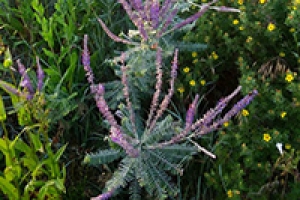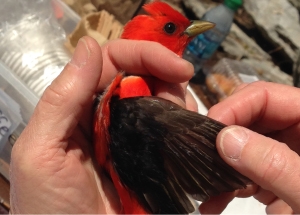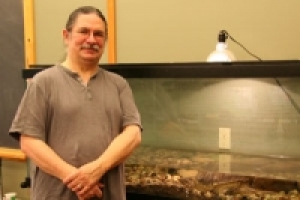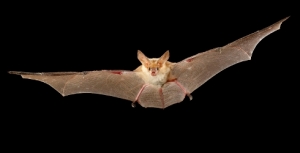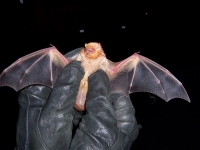
Help us Monitor Nocturnal Animals at a Mini-BioBlitz
Bring your friends and family and help us count and document the different animal species in the parks we manage this summer during our Mini-BioBlitzes.
Before we get any further, what the heck is a BioBlitz? Well, a BioBlitz is typically a 24-hour event that focuses on finding and identifying as many species of plants, animals, fungi, and any others organisms as possible in one area. The goal is to create a snapshot in time of everything that is present.
Experience the nocturnal biodiversity and ecological richness of the natural areas around our three branches during a 2-hour Mini-BioBlitz on July 22nd at Washington Park, August 19th at Riverside Park and August 21st at Menomonee Valley.
Native Plants to Know: Leadplant
Those who prefer instantaneous beauty or plump plants may give up on leadplant (Amorpha canescens) well before it reaches "maturity" at 5+ years of age, but the patient gardener will be rewarded with decades of drought resistant silvery foliage and purple flowers.
Collaborating to Conserve Bats
The Urban Ecology Center’s Research and Community Science program surveys about 30 different types of wildlife, including birds, mammals, reptiles, amphibians, and invertebrates. This amounts to an estimated 300 field research surveys per year! Among all of this, one project in particular stands out as being part of almost every single work day this spring and summer: acoustic bat monitoring.
See For Yourself - Research and Citizen Science
Our research program has two unique features: an urban habitat focus and the inclusion of volunteer community scientists.
The urban wilderness research and monitoring we do provides baseline data that allow us to track how our habitat improvements affect wildlife over time. We’re measuring the changes so others can replicate the results in other cities.
We are one of the leaders of an international movement to facilitate community-led research and monitoring. Our Community Science program focuses as much on the process of engaging community volunteers as it does on the research process itself. What this means is that everyone can contribute in a meaningful way to scientific research.
Thank a Bat if You Like Delicious Smoothies on a Hot Day!
When the word "bat" comes out in a conversation the first thing that many people think is about mosquitoes. We wonder how to get more bats in our backyards to have fewer mosquitoes. This is one of the roles bats play in nature, pest controllers. Bats find all kinds of insects to be tasty, like moths, grasshoppers, flies, and beetles to name a few. This not only makes our lives more comfortable, but in agriculture it can save lots of money that would be spent on pesticides.
How the Bat Got His Wings
Long-time Urban Ecology Center member Andy Connors is a born storyteller. Growing up within the Anishinaabe community along the Bad River in northern Wisconsin, Andy developed a strong sense of Native American identity through his ability to engage and connect with others through storytelling. To celebrate the upcoming Wisconsin Bat Festival, Andy tells a riveting traditional Native American story of how the bat got his wings.
Native Animals of the Month: Cave Bats
My mother gave me a deep appreciation for bats. She grew up in Texas, where any bat enthusiast knows, some of the world's most unbelievable bat hibernacula exist. She and her brother had a pet bat named Radar who they found as an orphan. They raised him (as I like to picture in a little matchbox, with tiny bat swaddling) until he grew stronger and older. Unfortunately Radar had an untimely run-in with a neighbor who was positive the bat had rabies. While my mother's memories of Radar faded, her fondness of him never did, and I have my mom to thank for sharing her love of an animal, that in the late-50's was completely uncool to love.
So There Are Bats in Riverside Park...But What Do They Do?
We know there are bats in Riverside Park. Hike a trail at dusk and you may see a Big Brown Bat fly overhead or even hear a few chirps if a bat is closing in on its prey. Because of their nocturnal aerial habits, bats make very difficult study subjects. But recent technological advances are allowing us more detailed glimpses into the habits and distribution of Wisconsin’s bats, including those in Riverside Park.
Bat Research
Bats are the second most diverse group of mammals in the world. There are over 900 known species, eight of which are found in Wisconsin. Bats provide important ecosystem services like insect control and pollination. Unfortunately, White-nose Syndrome (WNS), a deadly fungal infection, is spreading through North America at an alarming rate killing hundreds of thousands of bats.
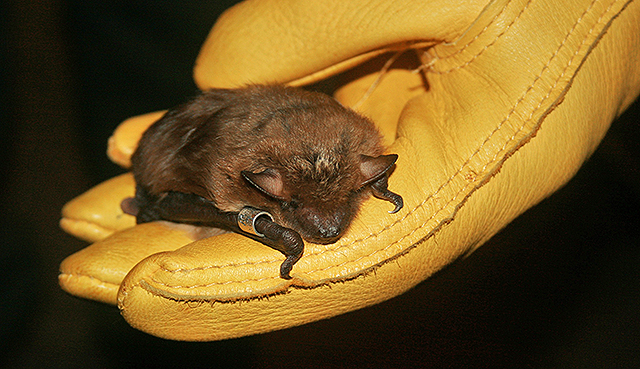 Big brown bats (Eptesicus fuscus), with a wingspan of 12-16 inches and an average weight of about an ounce, aren't actually all that big! Photo: Joe Meyer
Big brown bats (Eptesicus fuscus), with a wingspan of 12-16 inches and an average weight of about an ounce, aren't actually all that big! Photo: Joe Meyer
In collaboration with the Wisconsin DNR, the Urban Ecology Center is helping researchers determine baseline bat population dynamics using high-tech Anabat detectors that identify bats by recording their ultrasonic calls. A stationary detector records year-round from Riverside and mobile detectors help community researchers monitor bats on properties throughout Southeast Wisconsin. A GPS unit allows us to plot survey locations, as well as the time, location and often species identification of the bats we encounter.
If you are interested in helping the Urban Ecology Center research and monitor bats, please contact Maggie Steinhauer at This email address is being protected from spambots. You need JavaScript enabled to view it..
For more information on Wisconsin’s bats and WNS, please visit: http://wiatri.net/inventory/bats/

Teaching budding community scientists about the Anabat acoustic bat detector.
The Urban Ecology Center’s bat research has received valuable funding from:
- The Citizen-based Monitoring Network of the Wisconsin DNR’s Partnership Program.
- The Environmental Protection Agency’s Great Lakes Research Initiative
- And by a generous donation from Verne and Marion Read
The Center has also received collaborative support from the Wisconsin DNR, Escuela Verde, Mequon Nature Preserve and the University of Wisconsin Stevens Point.
Show you value bats in our urban ecosystem with a gift!
Copyright © 2023 The Urban Ecology Center


